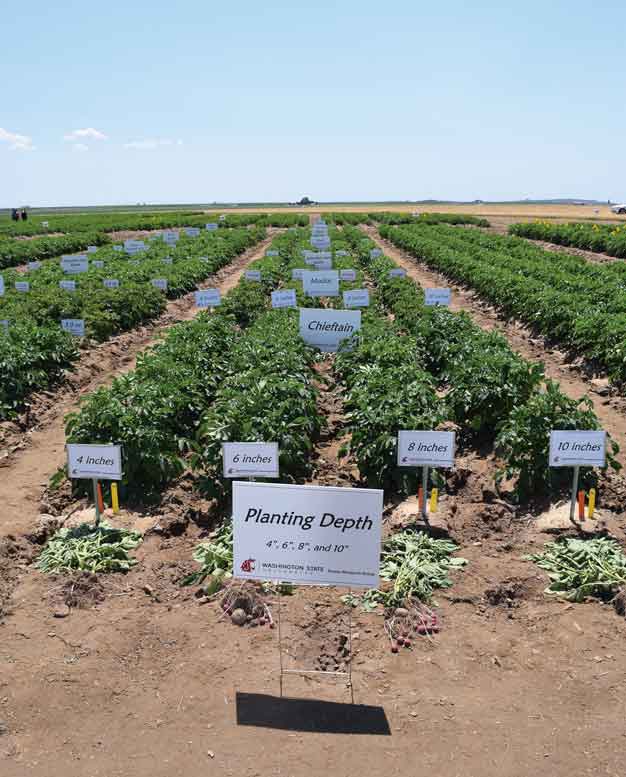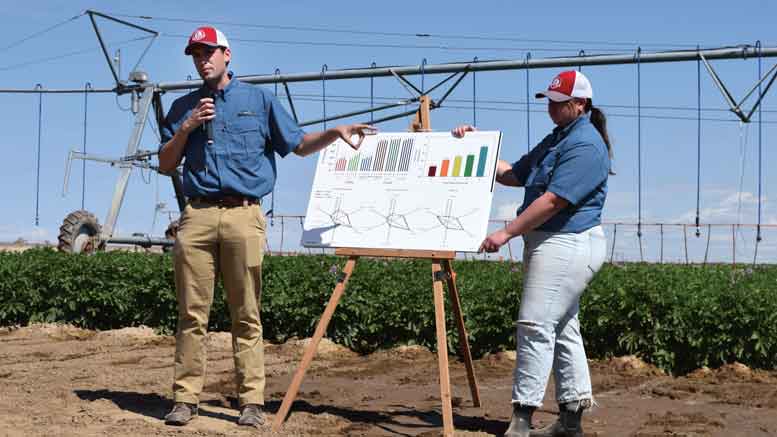|
Click to listen to this article
|
Story and photos by Denise Keller, Editor
Whether concerned with drought conditions or simply striving toward good stewardship, water use efficiency continues to be a priority for potato growers. The topic topped the agenda at this year’s Washington State University (WSU) Potato Field Day, held June 22 in Othello, Washington, as WSU Ph.D. student Jacob Meeuwsen shared details of a trio of trials underway.
“All three of these projects mainly look at how to maximize water efficiency,” he said. “We’re trying to figure out how to be wiser with the water we have available to us.”

Mobile Drip Irrigation
Of particular interest to growers was Meeuwsen’s trial evaluating the use of mobile drip irrigation in potatoes. He and his advisor, Mark Pavek, are assessing the feasibility, strengths and weaknesses of mobile drip irrigation compared to conventional overhead irrigation. The Dragon-Line equipment used in the trial turns a center pivot into a mobile drip irrigation system by running drip lines down the potato rows off the irrigation drop-downs that would normally have sprinkler heads attached. Essentially, this type of system is meant to allow the benefits of drip irrigation with the ease of overhead center pivot irrigation.
In the trial, which includes Ranger Russet, Clearwater Russet, Umatilla Russet and Russet Burbank, Meeuwsen is maintaining proper soil moisture through the use of conventional overhead irrigation in some rows and mobile drip irrigation in others.
“We expect that the plants getting the mobile drip irrigation treatment will use less water because it’s going directly to the root zone with very little water evaporating off the canopy,” Meeuwsen explained.
In addition to reducing water usage, mobile drip irrigation could lessen disease pressure, as keeping the plant canopy from getting wet reduces humidity and makes conditions less conducive for disease growth.
Mobile drip irrigation is used in corn, wheat and alfalfa and has been tried in potatoes in other growing regions, and it’s starting to gain traction, according to Meeuwsen.
“I think it’s super cool trying this mobile drip irrigation because if it does work, it will be a great tool for growers to use even when there’s not a water shortage,” he said.

Planting Considerations
In a separate trial, Meeuwsen is studying how plant population impacts water usage. This is the first year WSU has added a water use component to an ongoing trial on row spacing. Ranger Russet and Clearwater Russet potatoes planted at in-row spacing of 6, 9, 12 and 15 inches and at row widths of 32 and 34 inches are being irrigated at 60, 80, 100 and 120 percent of evapotranspiration (ET).
“I would expect as we see higher plant populations, the crop would use more water compared to a lower plant density,” Meeuwsen said.
Ultimately, data from the trial will help researchers advise growers on ideal spatial arrangements for planting during years with water restrictions or reductions. Recommendations will balance maximizing a grower’s water use efficiency and economic return on investment.

Early-Season Irrigation
The final trial looks at the effects of soil moisture deficit prior to emergence and from emergence to tuber initiation. This study stems from a thought in the industry that stressing plants early in the season results in deeper roots, which helps minimize heat stress later in the season. However, Meeuwsen pointed out, roots begin to develop before plant emergence. Therefore, not irrigating before emergence could stunt plants and reduce yield.
Ranger Russet, Clearwater Russet, Umatilla Russet and Russet Burbank plants are receiving one of three treatments: 1) a soil moisture deficit of <65 percent available soil moisture prior to emergence, then irrigated conventionally for the remainder of the season, 2) a soil moisture deficit one week after emergence, then irrigated normally for the remainder of the season, or 3) available soil moisture maintained at 65-85 percent throughout the season (control treatment).
“I would expect to see that the soil moisture deficit treatments will hurt yield. Roots begin to develop before you even see the plant come out of the ground and the plants are growing so fast right at emergence that if they don’t get enough water at that time, they will be stunted for the remainder of the season,” Meeuwsen said. “I think we will be able to show growers that early-season irrigation is very beneficial to the potato crop and yield and quality at harvest.”
For each of the three trials, Meeuwsen will measure yield as well as internal and external tuber quality at harvest. He will also look at fry quality and color in the early-season soil moisture deficit trial. The team will repeat the work next year before making recommendations.
Meeuwsen and Pavek received funding for these projects from the USDA/WSDA Specialty Block Grant Program, Northwest Potato Research Consortium, Washington State Potato Commission and WSU. Dragon-Line donated the mobile drip system.



